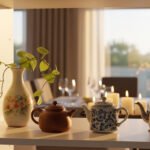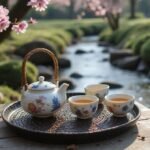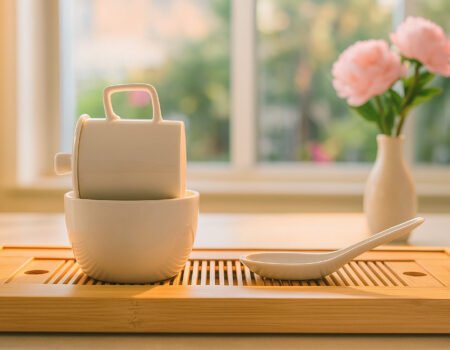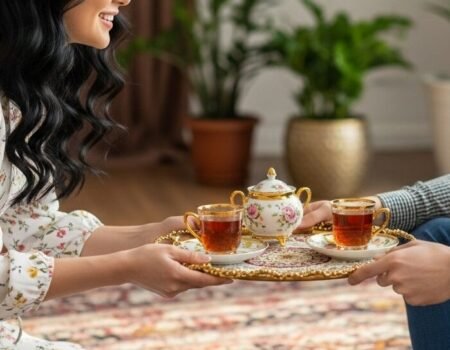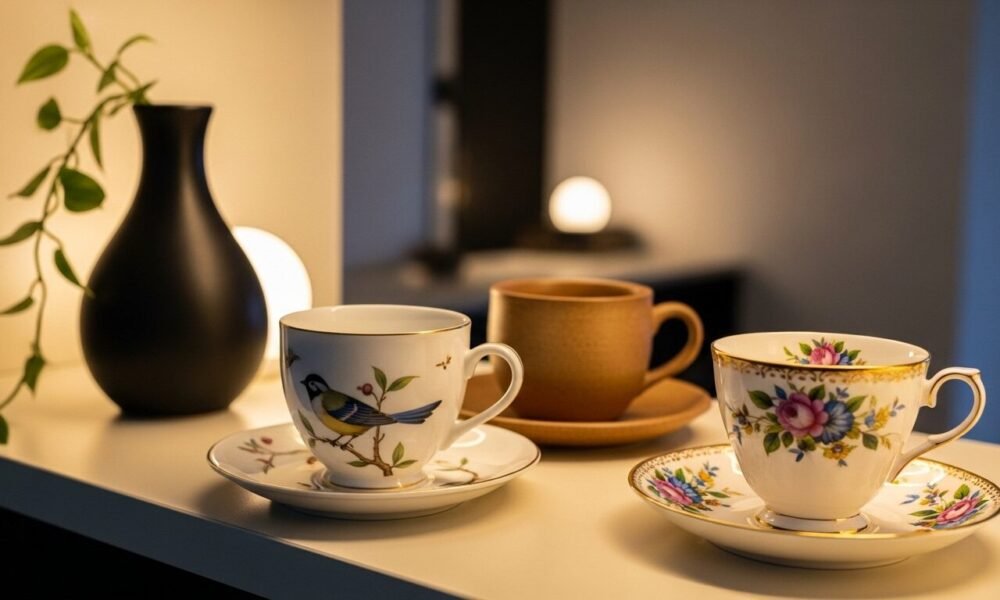
Tea Cups and More: Discover the Perfect Cup, Saucer and Mug
Index
Index
This guide will walk you through essential features of tea cups, saucers and mugs to match your tea drinking style. Discover how the right teacup can transform your daily ritual.
Key Takeaways
- Porcelain tea cups keep tea warm without changing its taste, with most traditional styles holding 2-3 ounces while larger varieties hold up to 16 ounces.
- Cup shape affects flavor perception – wide, shallow bowls cool tea faster and release more aromas, while deep, narrow cups maintain heat longer for black teas and oolongs.
- Different cultures created unique tea vessels, from China’s tiny porcelain cups to Japan’s matcha bowls (chawan) and India’s earthen kulhad cups that add subtle earthy flavors.
- Material choice matters greatly – porcelain and bone china retain heat well, while glass showcases tea color without absorbing flavors.
- The right cup matches your tea type – green tea works best in neutral porcelain, black tea pairs with wide-mouthed mugs, and white tea shines in glass cups that display its pale color.
Essential Characteristics of Tea Cups
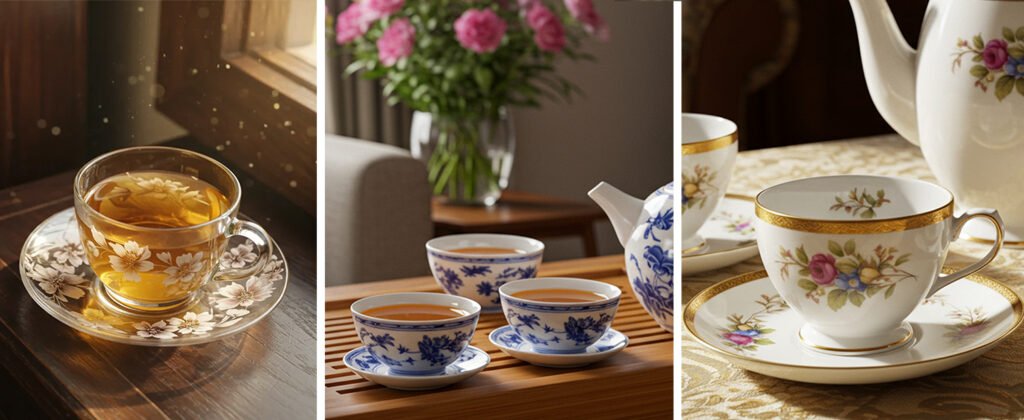
Tea cups differ from other vessels through specific traits that impact your tea experience. Each cup’s material, shape, and design affects how your tea tastes, smells, and feels in your hands.
Defining Tea Cups and Their Role
Tea cups serve as specialized vessels crafted specifically for tea drinking, distinct from their coffee counterparts in both size and design. These elegant containers typically hold between 2-3 ounces for traditional styles and up to 16 ounces for larger varieties.
Dating back to China’s Tang Dynasty, tea cups have evolved across cultures while maintaining their core purpose: to present tea at ideal temperatures and enhance the drinking experience.
The cup’s shape, material, and size all impact how we perceive tea flavors and aromas.
Porcelain and ceramic cups stand as preferred choices among tea enthusiasts due to their excellent heat retention properties. These materials keep your green tea, white tea, or herbal blends at perfect drinking temperatures longer than glass alternatives.
Many tea lovers collect various cup styles, from floral-decorated bone china sets with gold trim to rustic stoneware mugs with unique glazes. Each style brings its own aesthetic appeal and functional benefits to your tea time ritual.
Overview of Key Materials and Their Influence
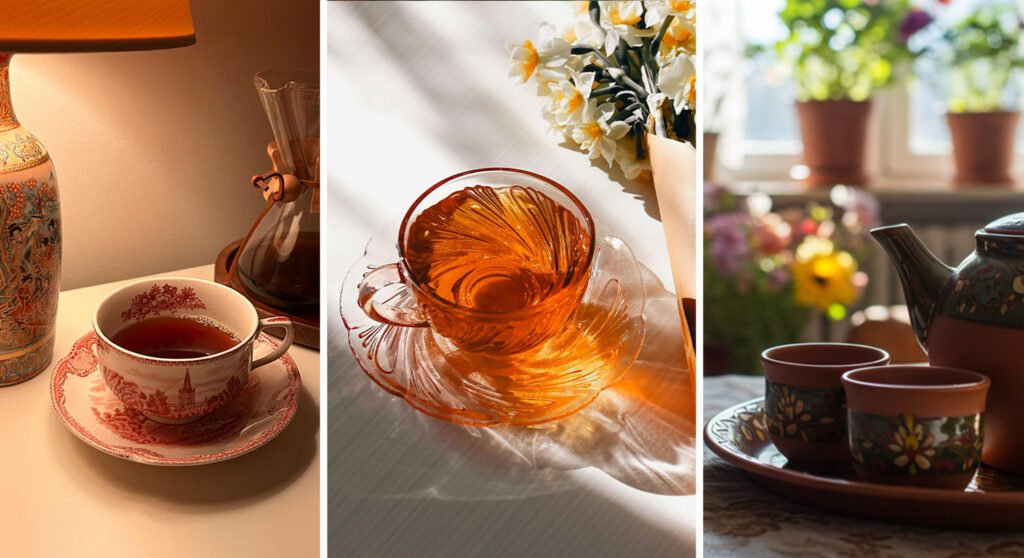
Now that we understand what tea cups are, let’s explore the materials that make them special. Tea vessels come in several key materials, each affecting your drinking experience in unique ways.
Ceramic options like porcelain stand out for their elegant appearance and excellent heat retention properties. Porcelain cups feature a translucent design that many tea enthusiasts prize for its sophistication and style.
Glass cups serve a different purpose by showcasing the tea’s color while enhancing its aroma—a crucial factor that impacts taste.
Materials matter greatly in how your tea tastes and feels. Porcelain and bone china have lower heat capacities with higher thermal conductivity, keeping your beverage at the right temperature longer.
For beginners, porcelain or ceramic cups offer the best starting point due to their durability and versatile nature. Each material brings its own character to your tea experience, from the classic white elegance of fine china to the rustic charm of stoneware.
The cup you select becomes both a functional tool and an expression of personal taste.
Ceramic Varieties: Porcelain, Bone China, Earthenware, and Stoneware
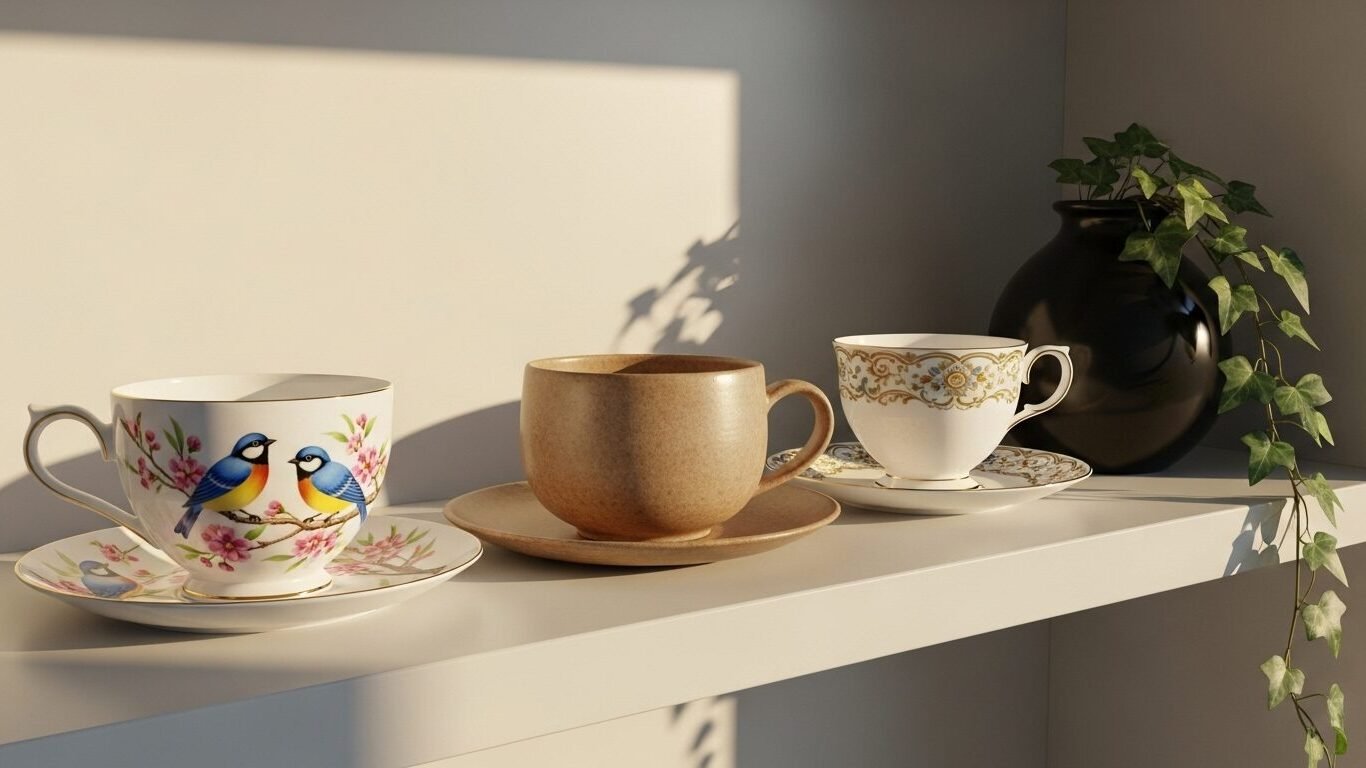
Porcelain tea cups stand out with their refined clay composition, offering remarkable strength and high heat resistance. These elegant vessels create a perfect backdrop for your afternoon tea or loose leaf tea experience.
Bone china cups contain at least 25% bone ash, making them the strongest ceramic option for your tea party needs. Many tea enthusiasts prize bone china tea sets for their durability and delicate appearance.
Earthenware represents the most affordable ceramic option but lacks durability compared to other materials. The rustic charm of earthenware suits casual tea drinking sessions but may not withstand daily use.
Stoneware cups offer a middle ground, fired at higher temperatures than earthenware, making them suitable for various hot beverages. Each ceramic type brings unique qualities to your tea cup collection, affecting both the aesthetics and practical aspects of your tea-drinking ritual.
Glass and Its Properties for Tea
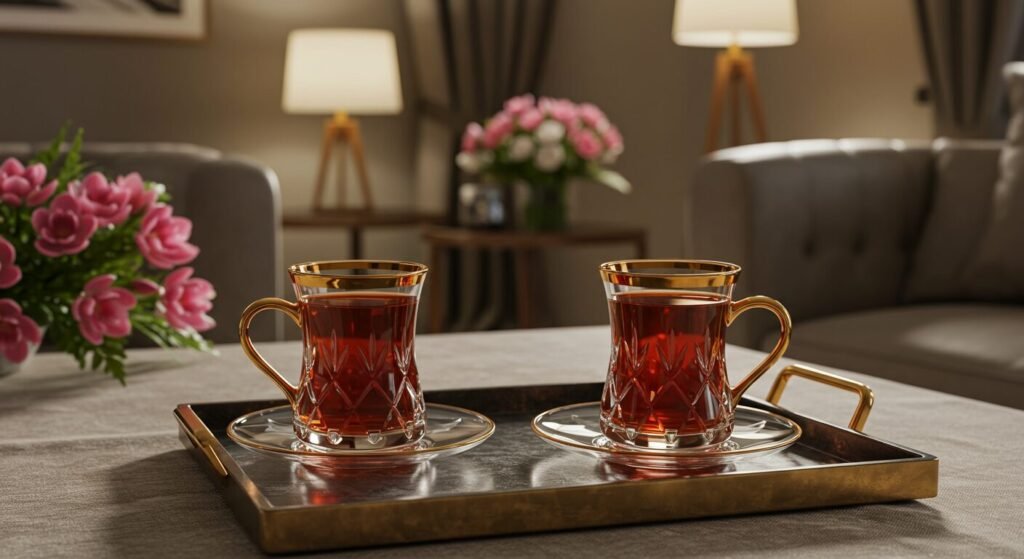
While ceramic options offer distinct characteristics, glass teacups provide unique benefits for tea enthusiasts. Glass vessels showcase tea’s visual beauty through their transparent nature.
Their non-porous surface prevents flavor absorption, allowing each brew to taste exactly as intended. European tea drinkers historically favored glass for this non-reactive quality.
Cup design greatly impacts your tea experience. Wider glass cups deliver more aroma to your nose during sipping. Thin-walled cups cool faster, which encourages mindful drinking but may not suit those who prefer prolonged warmth.
Many tea lovers appreciate borosilicate glass for its clarity and durability. This material stands up to temperature changes without cracking, making it perfect for both hot teas and iced tea varieties.
Diverse Tea Cup Traditions Around the World
Tea cups vary across cultures, with each country creating vessels that match their tea habits and values – from China’s tiny porcelain cups that showcase tea color to Morocco’s ornate glass cups that display mint tea’s vibrant green hue.
Chinese Gongfu Cups: Pin Bei and Wen Xiang Bei
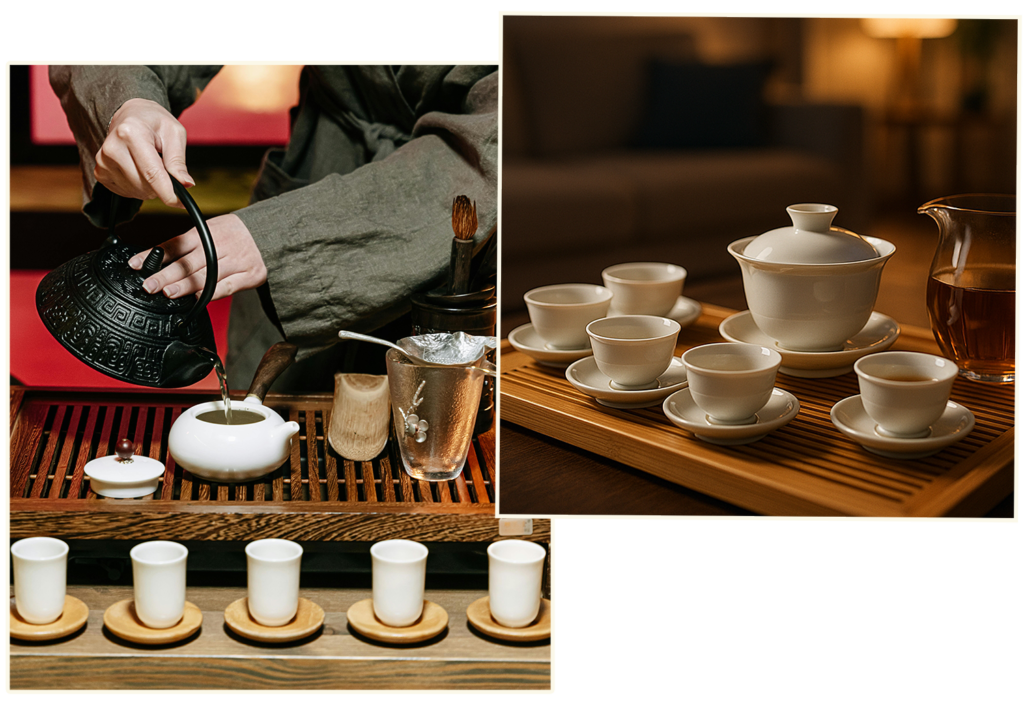
Chinese Gongfu tea cups come in two main types that serve different purposes. Pin Bei cups hold tea for drinking, while Wen Xiang Bei tall cups allow tea lovers to smell the aroma before tasting.
The Xiang Bei cup stands out with its pure white porcelain body and unique conical shape. This elegant vessel holds 240cc of tea and features subtle vertical ridges that provide a secure grip.
Its gentle flare at the rim creates a smooth drinking experience for tea fans. Many tea experts prefer these cups because porcelain maintains heat well without adding any taste to the tea.
The clean white color also helps drinkers see the true color of their brew. Japanese tea traditions show similar attention to detail in their unique vessels.
Japanese Chawan: The Matcha Bowl
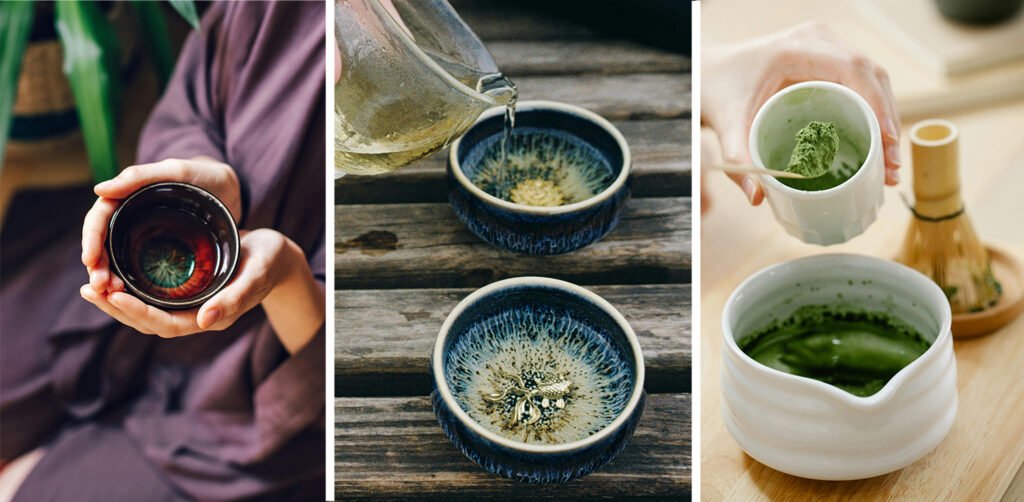
While Chinese tea culture focuses on small cups for appreciation, Japanese tea traditions center around the chawan. This special bowl serves as the heart of matcha preparation in Japanese ceremonies.
The chawan comes in several historical categories, with meibutsu chawan standing out as recognized masterpieces in the tea world.
Tea enthusiasts prize various chawan styles for their unique qualities. Tenmoku bowls feature dark glazes, while Seiji offers celadon green finishes. Sometsuke displays blue and white porcelain designs, and regional varieties like Ki-Seto and Oribe showcase distinctive local characteristics.
Modern tea lovers can find utsushi – faithful replicas of classic designs – that bring traditional craftsmanship to today’s tea experience. Many porcelain tea cup collectors start with these functional art pieces that transform simple tea drinking into a mindful practice.
British Teacups: Afternoon Tea Elegance
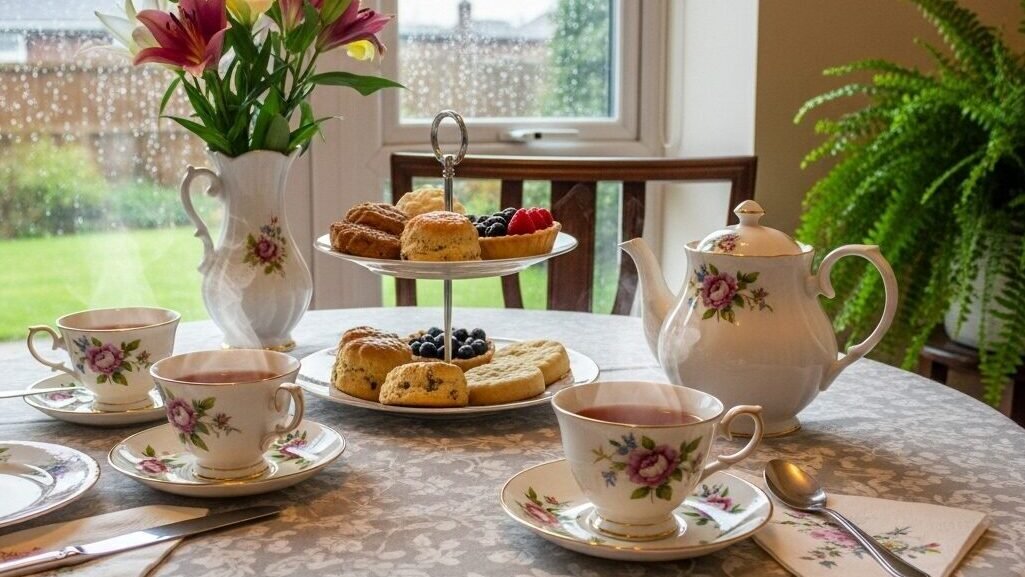
British teacups stand as icons of refinement with their delicate porcelain bodies and graceful handles. These cups typically feature gold rims and artistic motifs, like those in Wedgwood’s Wild Strawberry collection.
The perfect British teacup balances form and function—thin enough to feel elegant yet sturdy enough for daily use. Most traditional designs include matching saucers that catch drips and provide a resting place for spoons.
Tea culture in the UK values these cup and saucer sets as essential elements of afternoon gatherings. The Florentine collection offers colorful options that suit varied tastes while maintaining classic appeal.
Many British tea enthusiasts prefer bone china for its light weight and heat retention. Full tea sets make popular gifts for weddings and special occasions, with some families passing down their teacup and saucer sets through generations.
Indian Kulhad: The Earthen Chai Cup
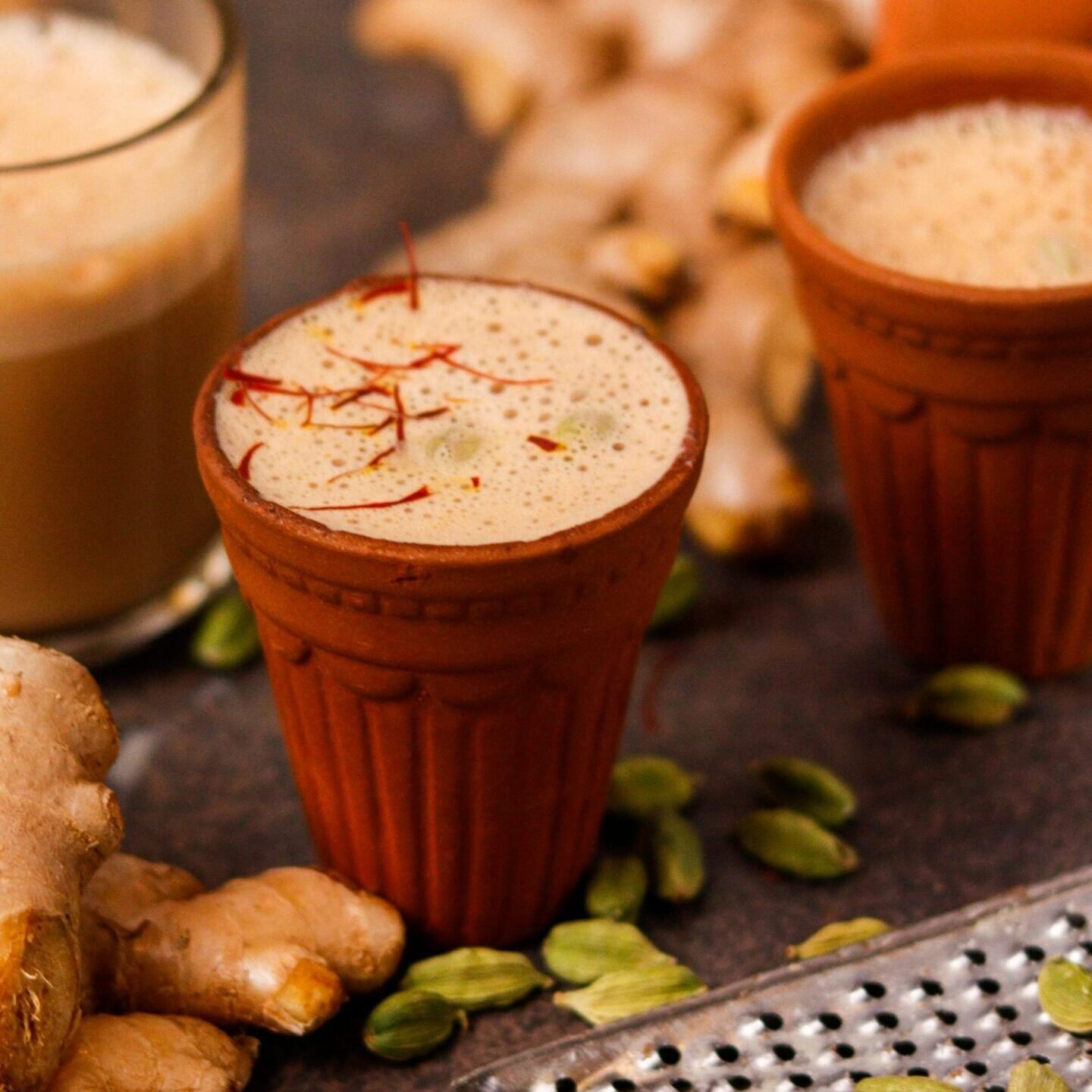
Kulhad chai stands as a symbol of India’s rich cultural heritage, with roots dating back to the ancient Indus Valley Civilization. These unglazed terracotta cups enhance chai flavor through their porous clay walls, which absorb some liquid while adding a subtle earthy taste that plastic or porcelain cannot match.
Many tea lovers prefer these traditional vessels because they create a complete sensory experience – from the warm touch of clay against your fingers to the aromatic steam rising from the cup.
Indian railways made kulhads famous by serving tea in these eco-friendly cups at train stations across the country. Each region crafts these cups with slight variations, showing local artistry and cultural preferences.
The cups are typically thrown away after one use since the clay absorbs the tea, making them naturally biodegradable alternatives to plastic or paper cups. This combination of tradition, sustainability, and flavor enhancement makes kulhads unique in teaware.
Moroccan Tea Glasses: Vessels for Hospitality
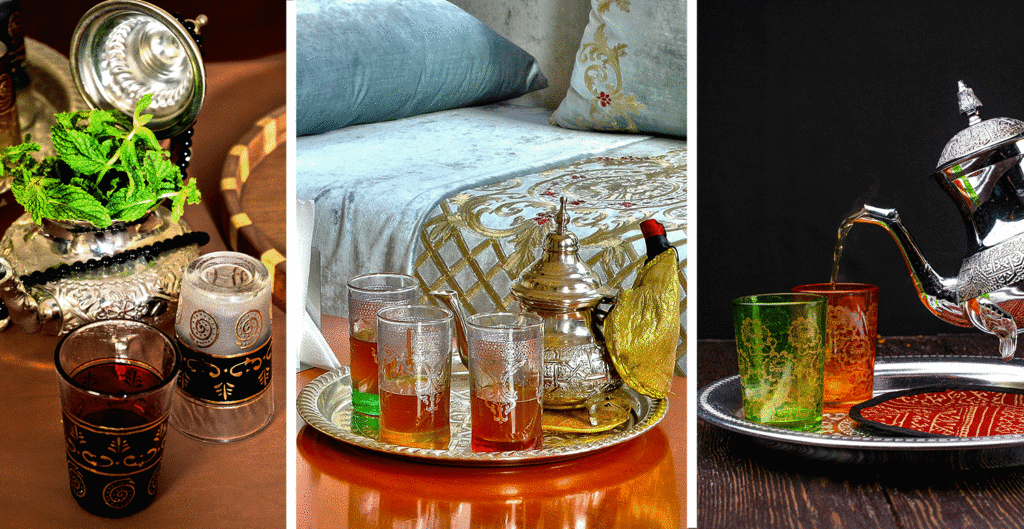
Moroccan tea glasses stand as colorful symbols of welcome in North African culture. These decorative vessels, often measuring 2.5 x 4 inches, feature unique style elements like intricate patterns and gold detailing that elevate any tea service.
The double-walled design of many Moroccan glasses helps insulate hot beverages while protecting hands from heat. Guests receive these glasses filled with sweet mint tea as a sign of friendship and respect.
The pouring ritual itself forms an important part of the experience, with hosts lifting the teapot high above the glasses to create a frothy top layer. Design elements of Russian tea vessels show similar attention to both function and cultural significance.
Russian Stakan with Podstakannik: A Samovar Companion
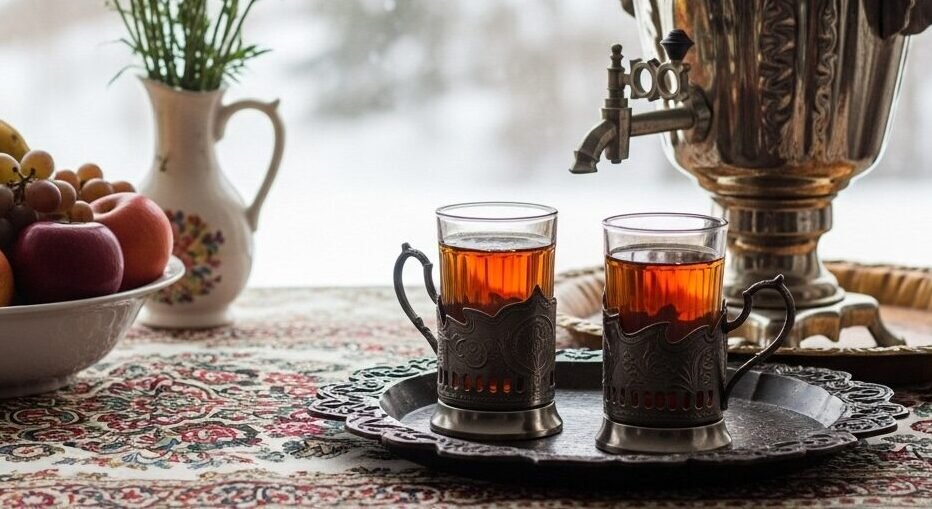
Russian tea glasses (stakan) pair with ornate metal holders called podstakannik, creating a unique drinking vessel. These holders protect hands from hot tea while adding artistic beauty to the experience.
The glass allows tea drinkers to enjoy the rich amber color of black tea served from a samovar. The podstakannik often features intricate designs that tell stories of Russian history or folklore, making them both functional accessories and works of art.
Vintage Soviet-era podstakanniks have become highly sought-after collectibles, commanding premium prices in the antique market. While most iconic in Russia, similar tea glass holders are cherished across Eastern Europe, Iran, and Georgia, each region adding its own design traditions to this practical yet elegant solution for serving hot tea.
Design Elements and Their Functional Impact
Tea cup designs affect more than just looks. The right shape and size can change how you taste and enjoy your tea.
How Cup Shape and Size Affect the Tea Experience
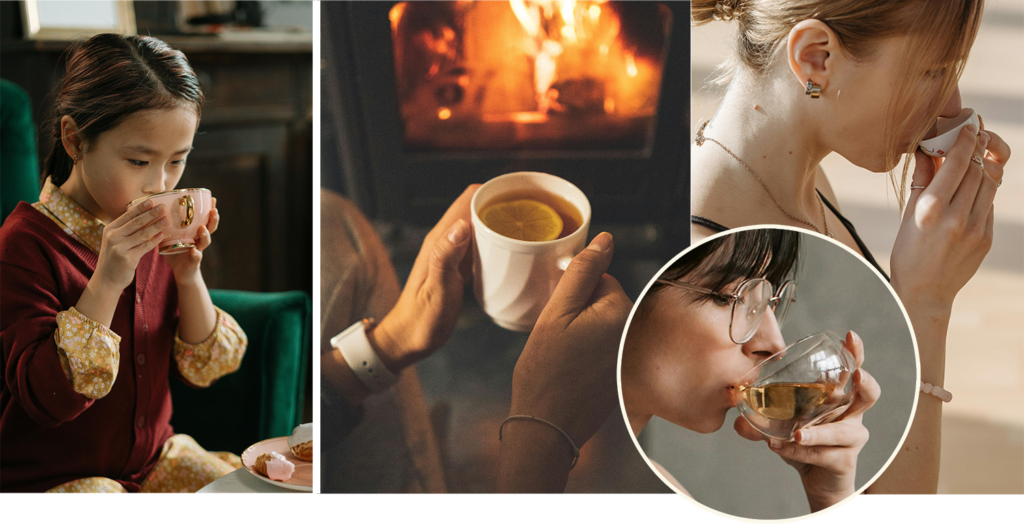
Tea cups come in various shapes and sizes, each dramatically changing how we taste our favorite brews. Wide, shallow bowls allow tea to cool faster and release more aromas to your nose while drinking.
This design choice isn’t random – studies show cup shape directly influences how bitter or sweet a tea seems. The same exact tea can taste noticeably different when served in a tall, narrow cup versus a wide, open one.
Your brain processes these sensory signals differently based on the cup’s form factor.
Cup size matters equally for your tea enjoyment. Smaller cups preserve heat longer but require more frequent refills. Larger vessels cool more quickly but offer a generous serving for leisurely sipping.
The rim thickness also plays a role in comfort and temperature control during drinking. Many tea enthusiasts match specific cup shapes to particular tea varieties – delicate white teas often pair with thin-walled porcelain while robust black teas might deserve a substantial mug.
Next, we’ll explore the significance of handles in tea cup design and how they contribute to both function and tradition.
The Significance of Handles in Tea Cup Design
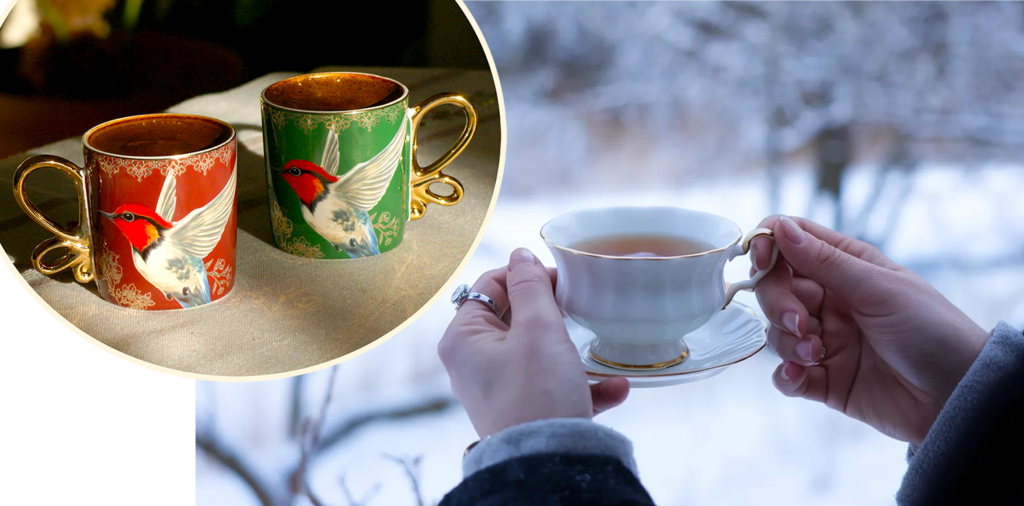
Tea cup handles offer more than just a way to hold your drink. Loop-shaped handles stand as the gold standard for comfort, allowing you to enjoy hot beverages without burning your fingers.
The handle design tells stories about when and where the cup was made, giving collectors valuable historical insights. Some unique options like Butterfly, Stump, and Ear shapes add visual appeal while serving practical purposes.
These different grip styles directly impact how we interact with our favorite drinks each day. The shape of a handle affects the overall cup design too, changing how tea flows to your lips and altering the drinking experience.
A well-designed handle balances beauty with function, making your porcelain cup both a joy to use and display. Your choice between a delicate teacup handle or a sturdy mug grip depends on the tea type and your personal drinking habits, which leads us to consider how cup shapes work alongside handles to create the perfect tea vessel.
Practical Considerations for Tea Cups
Tea cups demand careful selection based on what you plan to drink. Different teas perform best in specific vessels that enhance their unique flavors and aromas.
Selecting Cups Based on Tea Type and Brewing Method
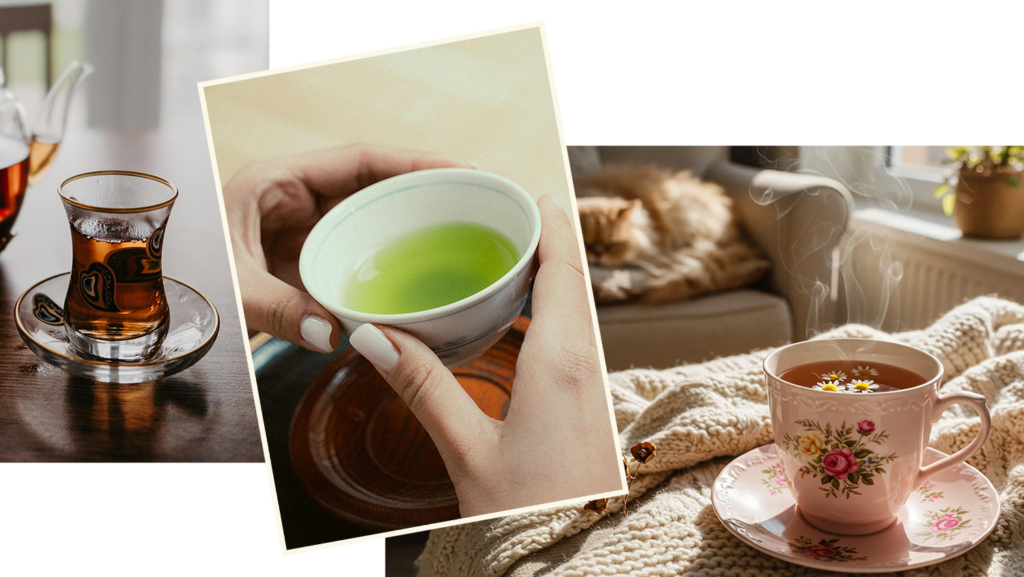
Selecting the right cup enhances your tea experience through both taste and aroma. Different tea types require specific vessels to bring out their best qualities.
Tea Types & Their Ideal Cups
- Green tea thrives in porcelain cups with their neutral material that preserves delicate flavors without adding unwanted tastes.
- Black tea pairs perfectly with wide-mouthed mugs that allow proper cooling and release of robust aromas.
- White tea demands glass tea cups which showcase its pale color while maintaining temperature stability.
- Oolong tea benefits from Pie Kou shaped cups that direct the tea to hit specific parts of your tongue, enhancing taste perception.
- Matcha requires deep, bowl-shaped vessels like the Japanese Chawan to accommodate whisking and proper froth formation.
- Herbal tea steeps best in large tea cups that provide ample space for botanicals to expand fully.
- Pu-erh tea deserves Zhi Kou (straight-mouthed) cups that help concentrate its earthy, complex flavors.
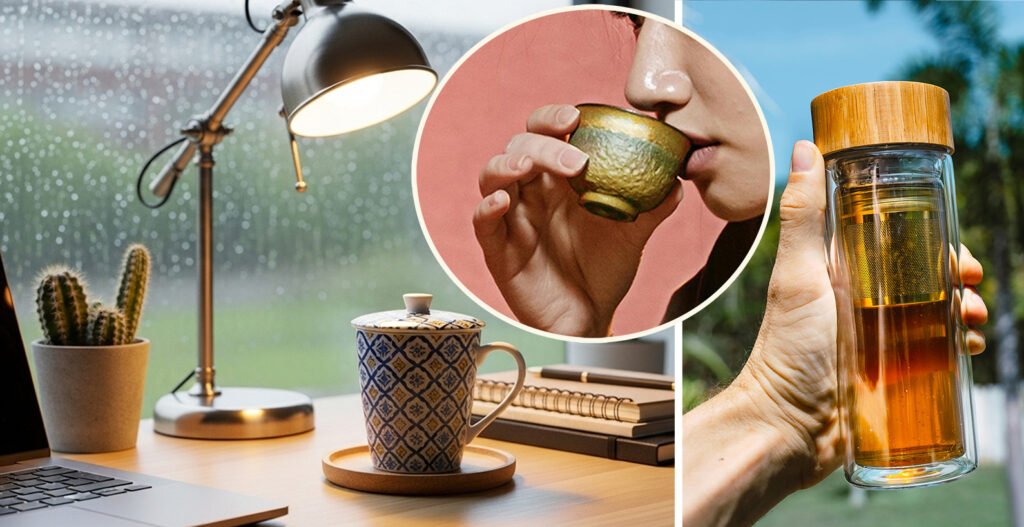
Cup Design & Material Impact
- Shallow, wide cups (Dou Li Bei) cool tea faster and suit delicate green or white teas that taste better at lower temperatures.
- Deep, narrow cups maintain heat longer and benefit black teas, pu-erhs, and dark oolongs that release flavors at higher temperatures.
- Cups with lids retain heat longer and prove ideal for slow-sipping teas like aged oolongs or dark teas.
- Material density affects taste perception, making porcelain and glass preferred choices for serious tea drinkers seeking pure flavor.
- Cup depth and width directly influence both aroma concentration and temperature retention during your tea session.
Special Brewing Situations
- Travel mugs with stainless steel infusers work for tea drinkers on the go, though they may slightly alter flavor profiles.
- Gongfu brewing calls for small Pin Bei cups that cool quickly and concentrate aromas for intense tasting sessions.
- British-style afternoon tea demands elegant tea cup and saucer sets with handles to prevent heat transfer to fingers.
Mugs as an Informal Tea-Drinking Option
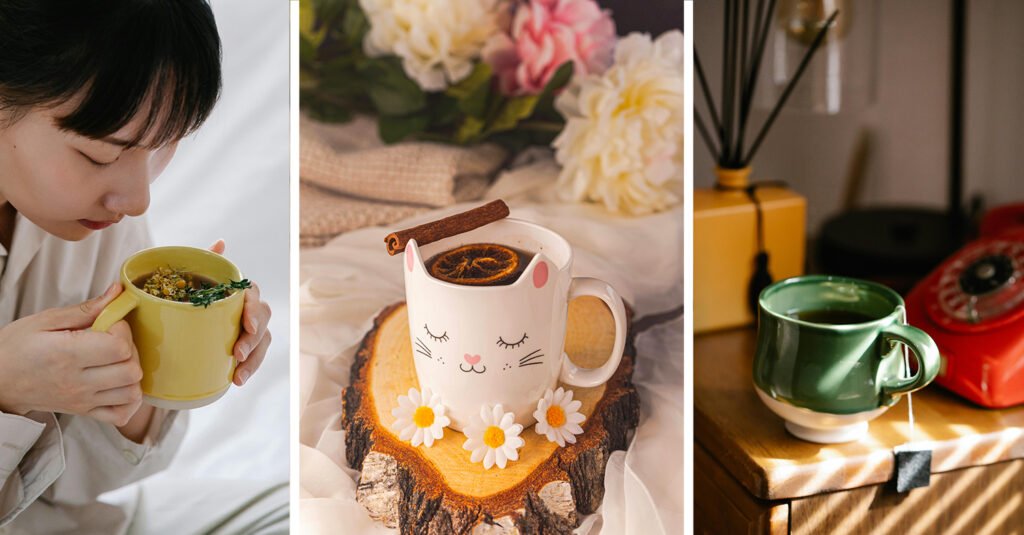
Tea mugs offer a casual alternative to formal teacups for daily enjoyment. These larger vessels hold between 35-45 cl of liquid, making them perfect for longer drinking sessions. Porcelain mugs provide excellent heat retention due to their substantial volume, keeping your tea hot while you work or relax.
Many tea lovers choose mugs for their morning brew or afternoon break because they require less refilling than traditional cups.
Materials like ceramic, glass, and porcelain each bring unique benefits to mug design. Porcelain coffee mugs combine elegance with durability, while ceramic options often feature colorful designs to brighten your tea experience.
The wide selection available means you can find tea mugs that match your personal style or interior design preferences.
Conclusion
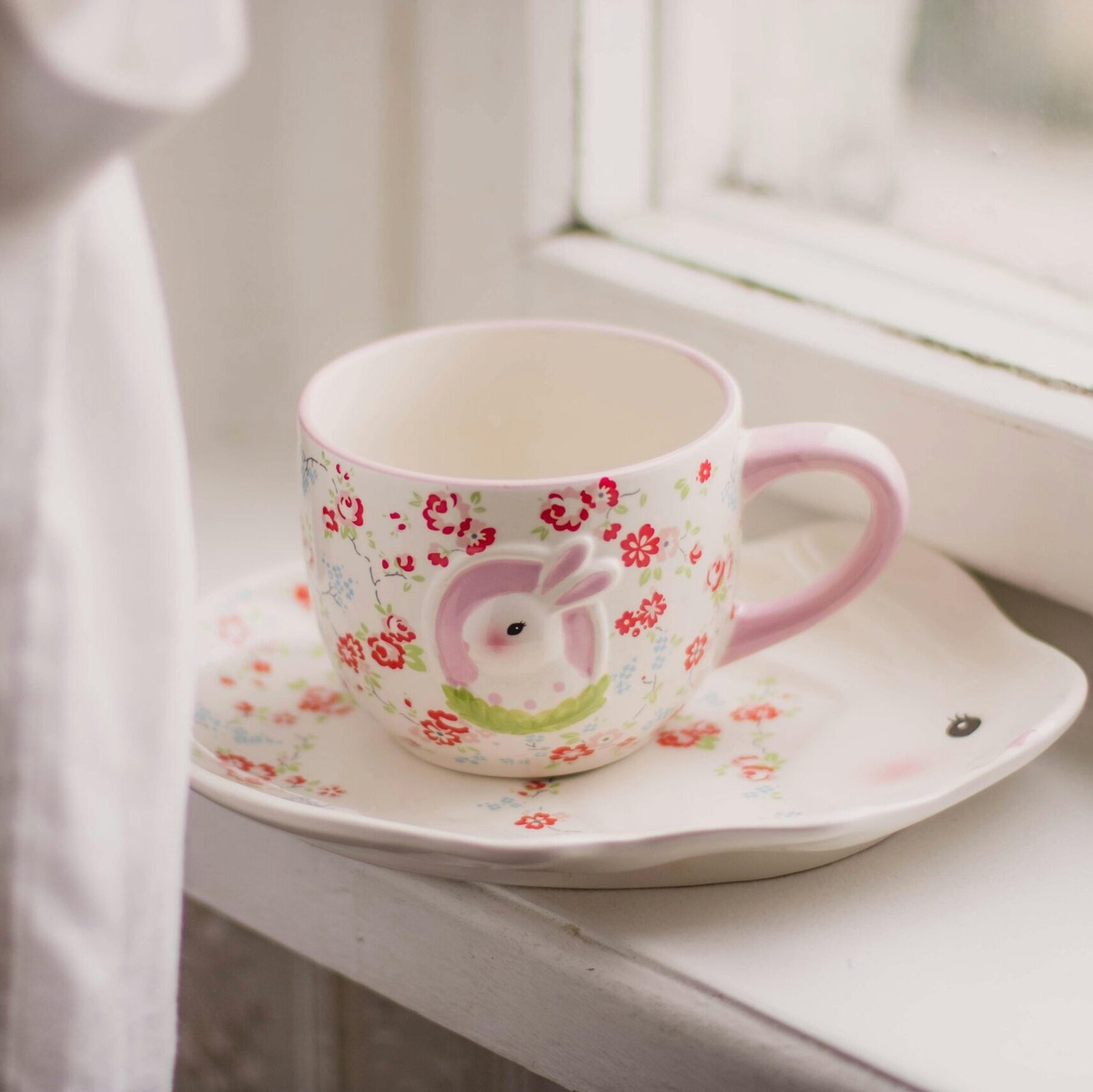
Porcelain tea cups blend beauty and function in ways that enhance every sip. Your choice of cup shapes the flavor, temperature, and overall experience of your favorite brew. From delicate Chinese pin bei to sturdy British afternoon tea sets, each tradition offers unique perspectives on this daily ritual.
The perfect porcelain vessel awaits you, whether you prefer a formal cup and saucer or a casual mug for daily use. Finding your ideal match means considering both personal style and the specific needs of your preferred tea varieties.
FAQs
1. What materials are best for tea cup sets?
Porcelain teacups offer the perfect balance of elegance and durability. We find that porcelain maintains heat well while showcasing colorful tea cups designs that many collectors seek. These cups are often available individually or as a set of 2 with matching saucers.
2. Can I use the same cups for tea and coffee?
Yes, many cups and mugs work for both beverages, though traditional porcelain teacups are smaller than coffee cups. The United Kingdom has a rich tradition of specific vessels for each drink, with coffee cups typically being larger to accommodate cappuccino and latte preparations.
3. What accessories should I look for with tea cups?
A tea infuser or strainer is essential for steeping loose tea properly. Some modern designs include a cup with lid that helps maintain temperature. For a complete experience, look for signature sets that include saucers as an important accessory.
4. Are paper tea cups environmentally friendly?
Some paper tea cups are now FSC-certified by the Forest Stewardship Council, making them more sustainable choices. These options are perfect for your next tea party when you need convenient serving options.
5. How do I choose between cups for different beverages?
Select deeper mugs for hot chocolate and coffee, which benefit from volume. Choose delicate porcelain teacups with wider openings for proper tea appreciation during a traditional Tea meal. Your selection should reflect both the beverage and the occasion.
References
- https://unifury.com/blogs/gifting-guide/tea-cups?srsltid=AfmBOopkrbcUdmZr5fI78GuczgWD4pju5__Lo1E3_8nwpKb3IuIVAGCe (2023-11-17)
- https://unifury.com/blogs/gifting-guide/tea-cups?srsltid=AfmBOoo-hl3qw2Nhja-u9JixNgpRCAdeUYlm3qSlYc6sjDKZhe2zxCFq
- https://grandlakecoffee.com/blog/coffee-cup-vs-teacup/
- https://whatahost.co.uk/blogs/what-a-host-blog/tableware-earthenware-stoneware-porcelain-bone-china-or-fine-china
- https://itsmorethantea.wordpress.com/2019/09/24/why-you-should-choose-your-teacup-carefully/ (2019-09-24)
- https://kingteamall.com/products/xiang-bei-tea-cup-3-variations-240cc?srsltid=AfmBOoqHC4kuXnHBLQM2B63XaNcIhfdMerZJV-ZWNQAsxp6PLZMAlht7
- https://www.jinyunfuteashop.com/teacups/bone-porcelain-kung-fu-tea-cups
- https://www.tezumi.com/blogs/tezumi-insights/know-your-chawan-a-guide-to-the-famous-matcha-bowl-styles?srsltid=AfmBOoo7ahGic-RFpyvw1337SscLeKeZ-fF3srwSAjrMZllQK7dq5hQ0
- https://www.wedgwood.com/en-us/tea-and-teaware/teaware/all-teaware?srsltid=AfmBOoqNebvbuuVr-4wDsD5LPDWq-8Lgql-GMPizPG-bG3FYEcaNnHWP
- https://shaopeng.blog/wanders/kulhad-chronicles-savouring-indias-diverse-flavours-in-terracotta-cups
- https://www.sheherazadehome.com/moroccan-tea-glasses/?srsltid=AfmBOoqBrVXFWdLVb-Oi57NGCnz28sbNwR7OGgR2gqsRmrtkpSowIEaK
- https://www.sheherazadehome.com/moroccan-tea-glasses/?srsltid=AfmBOoqemlhAAE-xtcxPksX8wQ8XlMDwcQSIWjNe7FvgCpUNYS5SCv2i
- https://www.ebay.com/itm/203779380565
- https://www.mdpi.com/2071-1050/11/24/6895
- https://account.faruj.sljol.info/index.php/sljo-j-faruj/article/view/193/84
- https://www.teadrunk.com/blogs/educational-articles/how-to-find-the-perfect-cup-for-your-tea?srsltid=AfmBOopB5AqvJZ_p6cZ46JmF6OfBU4WdpnjL3z-QWf2fS8XZwMPVzsDb (2024-07-28)
- https://www.thes-traditions.com/en/content/tea-mug

